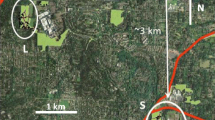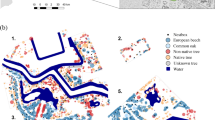Abstract
Urban sprawl is recognized to homogenize biota, with several species that fail to adapt to these new human scenarios. However, some species can live and breed successfully in urbanized habitats. We compared the breeding performance of the relatively common raptor and poorly studied, chimango caracara (Milvago chimango) in an urban gradient of central Argentina. Breeding data of 359 nests were collected during breeding seasons from 2010 to 2012. Birds nested in colonies of 3 – 75 pairs. Overall breeding success was 49.9% with productivity at 1 ± 1.14 chicks per nest. Models revealed that reproductive success and productivity were higher in nests with earlier laying dates and sited in larger colonies and that urbanization gradient did not affect either reproductive output or laying day. Urban habitats in central Argentina appear to provide similar reproductive success of chimango caracara than rural or natural habitats. Thus, chimango caracara shows behavioral plasticity for their successful persistence to human changes as reflected in successfully breeding in a wide variety of habitats such as natural, rural, and urbanized environments that have been impacted by humans.





Similar content being viewed by others
Data availability
Data are available on request.
References
Battin J (2004) When good animals love bad habitats: ecological traps and the conservation of animal populations. Conserv Biol 18:1482–1491
Bellocq M, Filloy J, Garaffa P (2008) Influence of agricultural intensity and urbanization on the abundance of the raptor chimango caracara (Milvago chimango) in the Pampean region of Argentina. Ann Zool Fennici 45:128–134
Biondi L, Bó M, Favero M (2005) Dieta del chimango (Milvago chimango) durante el periodo reproductivo en el sudeste de la provincia de Buenos Aires, Argentina. Ornitol Neotrop 16:31–42
Blair RB (1996) Land use and avian species diversity along an urban gradient. Ecol Appl 6:506–519
Boal C (2019) Urban raptor communities: why some raptors and not others occupy urban environments. In: Boal C (ed) Urban Raptors. Island Press, Washington, D.C.
Boal CW, Mannan RW (1999) Comparative breeding ecology of Cooper’s hawks in urban and exurban areas of southeastern Arizona. J Wildl Manage 63:77. https://doi.org/10.2307/3802488
Boggie MA, Mannan RW (2014) Examining seasonal patterns of space use to gauge how an accipiter responds to urbanization. Landsc Urban Plan 124:34–42. https://doi.org/10.1016/j.landurbplan.2014.01.001
Bond G, Burnside NG, Metcalfe DJ et al (2005) The effects of land-use and landscape structure on barn owl (Tyto alba) breeding success in southern England, U.K. Landsc Ecol 20:555–566. https://doi.org/10.1007/s10980-004-5037-7
Bonnington C, Gaston KJ, Evans KL (2015) Ecological traps and behavioural adjustments of urban songbirds to fine-scale spatial variation in predator activity. Anim Conserv 18:529–538. https://doi.org/10.1111/acv.12206
Botelho E, Arrowood P (1996) Nesting success of western burrowing owls in natural and human-altered environments. In: Bird CD, Verlan DE, Negro JJ (eds) Raptors in Human Landscapes: Adaptations to Built and Cultivated Environments. Academic Press Limited, New York, pp 61–68
Burnham KP, Anderson DR (2002) Model selection and multimodel inference: a practical information-theoretic approach (2nd ed)
Cardador L, Carrete M, Mañosa S (2012) Inter-individual variability and conspecific densities: Consequences for population regulation and range expansion. PLoS ONE 7:1–8. https://doi.org/10.1371/journal.pone.0033375
Cardilini A, Weston M, Nimmo D et al (2013) Surviving in sprawling suburbs: suburban environments represent high quality breeding habitat for a widespread shorebird. Landsc Urban Plan 115:72–80. https://doi.org/10.1016/j.landurbplan.2013.04.001
Carrete M, Sánchez-Zapata J, Tella J et al (2006) Components of breeding performance in two competing species: habitat heterogeneity, individual quality and density-dependence. Oikos 112:680–690
Carrete M, Tella J, Blanco G, Bertellotti M (2009) Effects of habitat degradation on the abundance, richness and diversity of raptors across Neotropical biomes. Biol Conserv 142:2002–2011. https://doi.org/10.1016/j.biocon.2009.02.012
Chamberlain D, Cannon A, Toms M, et al (2009) Avian productivity in urban landscapes: a review and meta-analysis. Ibis (Lond 1859) 151:1–18. https://doi.org/10.1111/j.1474-919X.2008.00899.x
Charter M, Izhaki I, Bouskila A, Leshem Y (2007) Breeding success of the Eurasian Kestrel (Falco tinnunculus) nesting on buildings in Israel. J Raptor Res 41:139–143
Delignette-Muller M-L, Dutang C (2015) fitdistrplus: An R Package for Fitting Distributions. J Stat Softw 64:1–34
Dunn PO, Møller AP (2014) Changes in breeding phenology and population size of birds. J Anim Ecol 83:729–739. https://doi.org/10.1111/1365-2656.12162
Dykstra CR, Hays JL, Simon MM (2009) Spatial and temporal variation in reproductive rates of the Red-shouldered Hawk in suburban and rural Ohio. Condor 111:177–182. https://doi.org/10.1525/cond.2009.080002
Fraga R, Salvador S (1986) Biología reproductiva del Chimango (Polyborus chimango). El Hornero 12:223–229
Gahbauer MA, Bird DM, Clark KE et al (2015) Productivity, mortality, and management of urban peregrine falcons in northeastern North America. J Wildl Manage 79:10–19. https://doi.org/10.1002/jwmg.803
Gehlbach F (1996) Eastern Screech Owls in suburbia: a model of raptor urbanization. In: Raptors in Human Landscapes Adaptations to built and cultivated environments. pp 69–74
Hogg JR, Nilon CH (2015) Habitat associations of birds of prey in urban business parks. Urban Ecosyst 18:267–284. https://doi.org/10.1007/s11252-014-0394-8
Kettel EF, Gentle LK, Quinn JL, Yarnell RW (2017) The breeding performance of raptors in urban landscapes: a review and meta-analysis. J Ornithol 159:1–18. https://doi.org/10.1007/s10336-017-1497-9
Kreiderits A, Gamauf A, Krenn HW, Sumasgutner P (2016) Investigating the influence of local weather conditions and alternative prey composition on the breeding performance of urban Eurasian Kestrels Falco tinnunculus. Bird Study 3657:1–11. https://doi.org/10.1080/00063657.2016.1213791
Kübler S, Kupko S, Zeller U (2005) The kestrel (Falco tinnunculus L.) in Berlin: investigation of breeding biology and feeding ecology. J Ornithol 146:271–278. https://doi.org/10.1007/s10336-005-0089-2
Leveau LM, Gorleri FC, Roesler I, González‐Táboas F (2022) What makes an urban raptor? Ibis (Lond 1859) 1–14. https://doi.org/10.1111/ibi.13062
Lin WL, Lin SM, Lin JW et al (2015) Breeding performance of Crested Goshawk Accipiter trivirgatus in urban and rural environments of Taiwan. Bird Study 62:177–184. https://doi.org/10.1080/00063657.2015.1005570
Marzluff JM (2017) A decadal review of urban ornithology and a prospectus for the future. Ibis (Lond 1859) 159:1–13. https://doi.org/10.1111/ibi.12430
McKinney M (2006) Urbanization as a major cause of biotic homogenization. Biol Conserv 127:247–260. https://doi.org/10.1016/j.biocon.2005.09.005
Millsap B, Breen T, McConnell E et al (2004) Comparative fecundity and survival of Bald Eagles fledged from suburban and rural natal areas in Florida. J Wildl Manage 68:1018–1031. https://doi.org/10.2193/0022-541X(2004)068[1018:CFASOB]2.0.CO;2
Møller A (2009) Successful city dwellers: a comparative study of the ecological characteristics of urban birds in the Western Palearctic. Oecologia 159:849–858
Morrison J, Phillips L (2000) Nesting habitat and success of the Chimango Caracara in southern Chile. Wilson Bull 112:225–232
Newton I (1979) Population ecology of raptors. T & AD Poyser, London
Parker JW (1996) Urban ecology of the Mississippi Kite. In: Bird CD, Verlan DE, Negro JJ (eds) Raptors in human landscapes. Academic Press Limited, New York, Adaptation to built and cultivate environments, pp 45–52
Pedrana J, Isacch J, Bó M (2008) Habitat relationships of diurnal raptors at local and landscape scales in southern temperate grasslands of Argentina. Emu 108:301–310
Rebolo-Ifrán N, Tella JL, Carrete M (2017) Urban conservation hotspots: Predation release allows the grassland-specialist burrowing owl to perform better in the city. Sci Rep 7:1–9. https://doi.org/10.1038/s41598-017-03853-z
Reynolds SJ, Ibañez-Álamo JD, Sumasgutner P, Mainwaring MC (2019) Urbanisation and nest building in birds: a review of threats and opportunities. J Ornithol 160:841–860. https://doi.org/10.1007/s10336-019-01657-8
Rose S, Sumasgutner P, Koeslag A, Amar A (2017) Does seasonal decline in breeding performance differ for an African raptor across an urbanization gradient? Front Ecol Evol 5:1–9. https://doi.org/10.3389/fevo.2017.00047
Rosenfield RN, Bielefeldt J, Affeldt JL, Beckmann DJ (1995) Nesting density, nest area reoccupancy, and monitoring implications for Cooper’s hawks in Wisconsin. J Raptor Res 29:1–4
Sasvari L, Hegyi Z (1994) Colonial and solitary nesting choice as alternative breeding tactics in Tree Sparrow Passer-Montanus. J Anim Ecol 63:265–274. https://doi.org/10.2307/5545
Schlaepfer M, Runge M, Sherman P (2002) Ecological and evolutionary traps. Trends Ecol Evol 17:474–480. https://doi.org/10.1016/S0169-5347(02)02580-6
Sellers KF, Shmueli G (2010) A flexible regression model for count data. Ann Appl Stat 4:943–961. https://doi.org/10.1214/09-AOAS306
Serrano D, Forero M, Donázar J, Tella J (2004) Dispersal and social attraction affect colony selection and dynamics of Lesser Kestrels. Ecology 85:3438–3447
Sol D, Lapiedra O, González-Lagos C (2013) Behavioural adjustments for a life in the city. Anim Behav 85:1101–1112. https://doi.org/10.1016/j.anbehav.2013.01.023
Solaro C (2018) Costs and benefits of urban living in raptors. In: Sarasola J, Grande J, Negro J (eds) Birds of Prey Biology and conservation in the XXI century. Springer International Publishing AG part, Cham, Switzerland, pp 177–196
Solaro C, Sarasola JH (2019) Urban living predicts behavioural response in a neotropical raptor. Behav Processes 169:103995. https://doi.org/10.1016/j.beproc.2019.103995
Solaro C, Sarasola JH (2015) Nest-spacing, not human presence, influences the breeding of Chimango Caracaras (Milvago chimango) in a peri-urban reserve. Emu 115:72–75. https://doi.org/10.1071/MU14038
Steenhof K, Newton I (2007) Assessing nesting success and productivity. In: Bird DM, Bildstein KL (eds) Raptor Research and Management Techniques. Hancock House Publisher, pp 181–192
Stout W, Anderson RK, Papp JM (1998) Urban, suburban and rural Red-tailed Hawk nesting habitat and populations in southeast Wisconsin. J Raptor Res 32:221–228. https://doi.org/10.1080/00958970600794008
Stout W, Temple S, Papp J (2006) Landscape correlates of reproductive success for an urban-suburban Red-tailed Hawk population. J Wildl Manage 70:989–997
Sumasgutner P (2013) Diet specialisation and breeding success along an urban gradient: the kestrel (Falco tinnunculus) in Vienna, Austria. Beiträge Zur Jagd Und Wildforsch 38:385–397
Sumasgutner P, Millán J, Curtis O et al (2016) Is multiple nest building an adequate strategy to cope with inter-species nest usurpation? BMC Evol Biol 16:97. https://doi.org/10.1186/s12862-016-0671-7
Sumasgutner P, Schulze CH, Krenn HW, Gamauf A (2014a) Conservation related conflicts in nest-site selection of the Eurasian Kestrel (Falco tinnunculus) and the distribution of its avian prey. Landsc Urban Plan 127:94–103. https://doi.org/10.1016/j.landurbplan.2014.03.009
Sumasgutner P, Nemeth E, Tebb G et al (2014b) Hard times in the city – attractive nest sites but insufficient food supply lead to low reproduction rates in a bird of prey. Front Zool 11:48. https://doi.org/10.1186/1742-9994-11-48
Tella J, Hiraldo F, Donázar-Sancho J, Negro J (1996) Costs and benefits of urban nesting in the lesser kestrel. In: Bird CD, Verlan DE, Negro JJ (eds) Raptors in Human Landscapes: Adaptations to Built and Cultivated Environments. Academic Press Limited, New York, pp 53–60
Travaini A, Rodríguez A, Ceballos O et al (1995) Roadside raptor surveys in Central Argentina. Hornero 014:64–66
Verhulst S, Nilsson J-A (2008) The timing of birds’ breeding seasons: a review of experiments that manipulated timing of breeding. Philos Trans R Soc B Biol Sci 363:399–410. https://doi.org/10.1098/rstb.2007.2146
Welch-Acosta BC, Skipper BR, Boal CW (2019) Comparative breeding ecology of Mississippi Kites in urban and exurban areas of West Texas. J F Ornithol 90:248–257. https://doi.org/10.1111/jofo.12303
White C, Olsen P, Kiff L (1994) Order Falconiformes – Family Falconidae (Falcons and Caracaras). In: del Hoyo J, Elliot A, Sargatal J (eds) Handbook of the Birds of the World, vol 2. New World Vultures to Guineafowl. Lynx, Barcelona, pp 216–277
Acknowledgements
We express our thanks to Andrea Costán and countless collaborators for their field assistance, to Juana, Juan and Maximiliano of La Armonía ranch for their help and permission to work in this site, to community of neighbors of La Cuesta del Sur for their permission to enter their land and to the commissionors of Golf Club and Club de Caza Mappú Vey Puudú for authorizing our work at these sites. We appreciate the improvements in English usage made by Peter Lowther and Pam Denmon through the Association of Field Ornithologists' program of editorial assistance. This work was conducted under permits for the use of wild animals in research awarded by Dirección de Recursos Naturales, Ministerio de la Producción, Gobierno de La Pampa.
Author information
Authors and Affiliations
Contributions
Conceptualization: Claudina Solaro and José Hernán Sarasola; Methodology: Claudina Solaro; Formal analysis and investigation: Claudina Solaro; Writing—original draft preparation: Claudina Solaro; Review: Claudina Solaro.
Corresponding author
Ethics declarations
Conflicts of interest
We have no conflicts of interest to declare.
Supplementary Information
Below is the link to the electronic supplementary material.
Rights and permissions
Springer Nature or its licensor (e.g. a society or other partner) holds exclusive rights to this article under a publishing agreement with the author(s) or other rightsholder(s); author self-archiving of the accepted manuscript version of this article is solely governed by the terms of such publishing agreement and applicable law.
About this article
Cite this article
Solaro, C., Sarasola, J.H. Breeding performance is explained for coloniality and phenology but not for urbanization in a generalist raptor bird. Urban Ecosyst 26, 743–753 (2023). https://doi.org/10.1007/s11252-022-01319-3
Accepted:
Published:
Issue Date:
DOI: https://doi.org/10.1007/s11252-022-01319-3




